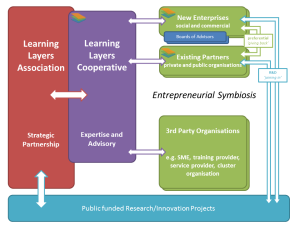Learning Layers in dialogue with DigiProB project – Part One: Preparations for the new project
Our EU-funded Learning Layers (LL) project has recently entered an interesting new phase. In the Construction pilot the Learning Layers project has a chance to work together and share experiences with a spin-off project. Recently, the German-funded DigiProB has also started its work in the German construction sector. Two LL partner organisations – the training centre Bau-ABC and the research institute ITB – play a major role in the new project that can be called as a spin-off from the LL project. Whilst the LL project is focusing on workplace learning from the perspective of skilled workers and apprentices, the DigiProB project shifts the emphasis on training of construction site managers. With this series of blogs I try to give a picture of the conceptual preparation for the new project (part one), on the lessons to be learned with initial interviews (part two) and on the prospects for using LL tools in the new project.
I start by looking back at a symposium at the European Conference on Educational Research (ECER 2015) in Budapest that was initiated by the LL team of ITB. In the symposium we brought together three recently completed or ongoing projects with focus on digital media, web tools and support for workplace learning. With their recent work the three projects (Kompetenzwerkstatt, Learning Layers and EmployID) had -reached a transition stage. From this perspective the symposium provided an opportunity to learn from each other and to draw conclusions for a new phase activities. Below, I will focus on the contribution of the LL team in this symposium and on the interim conclusions from the discussion.
Outline of DigiProB presented in an ECER symposium in Budapest 2015
In our contribution to the symposium we shifted the emphasis from the Learning Layers project to a designed spin-off project (DigiProB) which we expected to be start soon. The context of this project is the training of construction site managers – a vocational progression route for former skilled workers.
In a recent reform the training of certified construction site managers (Geprüfte Polier) has been regulated with new nationwide standards. The tasks of the certified construction site managers include organisation and controlling of work processes, supervision of construction workers, subcontractors and apprentices as well as monitoring the compliance with health and safety regulations. The new examination model with integrative tasks and project work seeks to push forward a more holistic learning culture.
The major challenge for adapting the new requirements in the training scheme lies in the construct of the curriculum. In general, the curriculum is based on a two-phase model. The first phase (ca. two months) is provided by presence courses in the training centre. During this period external part-time lecturers provide courses in the main areas of expertise for the future construction site managers. The second phase (which has now been shaped in the light of the new regulation) is based on self-organised learning activities of the participants alongside work. This phase includes integrative learning tasks and production of a coherent project report. With the integrative tasks the participants are expected to demonstrate their capability to manage complex construction sites and supervise related work processes. The project report should make transparent their competences in planning, preparing, implementing, documenting and assessing construction projects.
The task of the DigiProB project is to introduce digital media and web tools to support integrative learning of the participants (with the learning tasks and project work) and pedagogic reorientation of the trainers (to facilitate the learners in such learning). Here, the new project DigiProB should take into account the prior work of the Learning Layers project.
Interim conclusions of the discussion at the ECER symposium
In its contribution the ITB team drew attention to following tensions between the new requirements, the traditional mode of delivering the courses and lack of support for the self-organised learning:
- The new training regulation was introduced with short introduction events that familiarised the trainers on the new guidelines. However, these events did not provide an in-depth training for trainers to adjust themselves to new requirements.
- The part-time trainers are engaged as subject specialists and responsible for specific blocks in the presence training. They do not have an overarching responsibility on the supervision of integrated learning tasks and project work.
- There has been no clear model for developing online support, arranging peer tutoring and promoting peer learning among the participants.
The interim conclusions of the ITB team were formulated as follows: For the new spin-off project it is necessary to build upon the experience with the Learning Layers pilot but to take into account the differences between presence learning within training centre (supervised by full-time trainers) and dispersed self-organised learning (supervised by part-time trainers). Secondly, it is essential to equip the trainers with didactic know-how and learning technologies to support the dispersed learning activities. Thirdly, it is crucial to facilitate peer learning among the participants and to raise their awareness of their own learning.
– – –
At this point I leave our discussions at the ECER symposium behind. Now that the DigiProB project has started its initial activities, it is interesting to see, what kind of new experiences we are making and how the initial picture starts to change. From this perspective it is interesting to have a look, what we are learning from the initial interviews and from the dialogues on the usability of LL tools in the new project. These topics will be discussed in the next posts of this series.
More blogs to come …

